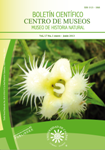Authors
Abstract
A floristic characterization associated with the Dendrobatidae (Amphibia: Anura) habitat was carried out in the Piangüita community (3°48'30"N, 77°11'32"W), northwest of Buenaventura on the Colombian Pacific coast. For this purpose, Gentry belt transects were used to make a census, in a 0.1 ha area in which all individual plants had a dbh of≥1 cm (measured at 1.3 m above the ground). In this, from very humind to pluvial tropical forest,, 855 individuals, distributed in 110 families, 308 genera, and 407 species were found in 10 transects (0.1 ha).. With the data obtained and organized, different structural parameters were calculated. The families with the highest Importance Value Index (IVI) were Arecaceae (1.91), Rapateaceae (0.34), Moraceae (0.12), Melastomataceae (0.11), Rubiaceae (0.095), Euphorbiaceae (0.073), Fabaceae (0.066), Marantaceae (0.038), and Myristicaceae (0.025). The distribution curve of the individuals is in the form of an inverted "J". The Shannon-Wiener diversity index is 3.08; the species accumulation curve was not asymptotic. Dendrobatidae frogs were found in five out of the 10 transects made.
References
CHAZDON, R. L. &KAUFFMANN, S., 1993. Plasticity of leaf anatomy of two rain forest shrubs in relation to photosynthetic light acclimation. Functional Ecology, 7: 385-394.
CHAZDON, R. L. & MONTGOMERY, R. A., 2003. La adquisición de Carbono en las plantas: 225-250 (en)GUARIGUATA, M. R. & KATTAN, G. H.(ed.) Ecología y conservación de bosques neotropicales. Libro Universitario Regional, Cartago, Costa Rica.
CLARK, D. B., 2003. Los factores edáficos y la distribución de las plantas: 193-221 (en) GUARIGUATA, M. R. & KATTAN, G. H.(ed.) Ecología y conservación de bosques neotropicales. Libro Universitario Regional, Cartago, Costa Rica.
COLWELL, R. 2005. ESTIMATES versión 7.5.0. [en línea] desde http://viceroy.eeb.uconn.edu/estimates.
DALY, J. W.,KANEKO, T., WILHAM, J., GARRAFO, H. M., SPANDE,T. F., ESPINOSA, A.&DONNELLY, M. A., 2002. Bioactive alkaloids of frog skin: Combinatorial bioprospecting reveals that pumiliotoxins have an arthropod source. PNAS 99(22): 13996-14001.
DEVIA, W., CÁRDENAS, D.& COGOLLO, A., 1994. Contribución al estudio florístico de la Reserva Natural del Río Escalarete, Buenaventura, Colombia. Universidad del Valle, Facultad de Ciencias, Departamento de Biología. 567 p.
ESPINAL, L. S., 1977. Zonas de vida o formaciones vegetales de Colombia. IGAC, 13 (11): 1-100.
FABER-LANGENDOEN, D. & GENTRY, A. H.,1991. The structure and diversity of rain forests at BajoCalima, Chocó Region, western Colombia. Biotropica, 23(1): 2-11.
FEINSINGER, P., 2003. El diseño de estudios de campo para la conservación de la biodiversidad. Editorial FAN, Santa Cruz de la Sierra, Bolivia. 242 p.
GENTRY, A. H., 1986. Species richness and floristic composition of Choco region plant communities. CALDASIA, 14: 71-91.
GENTRY, A. H., 1988. Changes in plant community diversity and floristic composition on environmental and geographical gradients. Annals of the Missouri Botanical Garden, 75: 1-34.
GENTRY, A. H. (ed.), 1990. Four neotropical rainforests. Yield Univ. Press, New Haven, CT.
GENTRY, A. H. &DODSON, C., 1987. Contributions of non trees to species richness of a tropical rain forest. Biotropica, 19: 149-156.
GRUBB, P.J. &WHITMORE, T. C., 1966. A comparison of montane and lowland rain forest in Ecuador. The climate and its effects on the distribution and physiognomy of the forest.Journal of Ecology, 54 (2): 303-333.
HARTSHORN, G. S., 2003. Biogeografía de los bosques neotropicales: 59-82 (en) Ecología y conservación de bosques neotropicales. Libro Universitario Regional, Cartago, Costa Rica.
HERRERA, L., 2003. Estructura de la comunidad de macroinvertebrados asociados a suelos blandos de manglar en Piangüita, Bahía de Buenaventura. Universidad del Valle, Facultad de Ciencias. 66p.
KREBS, C. J., 1985.Ecología. Estudio de la distribución y la abundancia. México,Harla. 753p.
MANZANILLA, J. & PEFAUR, J. E., 2000. Consideraciones sobre métodos y técnicas de campo para el estudio de anfibios y reptiles. Revista Ecológica Latino Americana, 7 (3): 17-30.
MELO, O. A., 1994. Estructura y biodiversidad de los bosques húmedos tropicales de colinas bajas del litoral pacífico colombiano. Buenaventura, Colombia. Universidad del Valle, Facultad de Ciencias, Departamento de Biología. 567 p.
MONSALVE, M., 1994. Flora de Bajo Calima. Buenaventura, Colombia.Universidad del Valle, Facultad de Ciencias, Departamento de Biología. 567 p.
PARDO, M. E. &CEDIEL, J., 1994. Composición y diversidad florística de los bosques de Cabo Corrientes, Costa Pacífica del Choco. Buenaventura, Colombia.Universidad del Valle, Facultad de Ciencias, Departamento de Biología. 567 p.
PERES, C. A., 1994. Composition, density, and fruiting Phenology of Arborescent Palms in an Amazonian Terra Firme Forest. Biotropica, 26(3): 285-294.
PERRY, D. R., 1985. Ecología de la selva tropical húmeda. Investigación y Ciencia, 100: 64-73.
RANGEL, J. O. & LOZANO, G., 1986. Un perfil de vegetación entre La Plata (Huila) y el volcán Puracé. Caldasia, 14(68-70): 53-547.
RENGIFO, J. M., 1997. Ranas y sapos de Colombia. Medellín, Editorial Colina. 160p.
RENTERIA, C., 2004. Estudio de la estructura y diversidad del estrato arbóreo y arbustivo de un bosque muy húmedo tropical comunidad Santa Clara (bahía de Buenaventura), como una herramienta básica para su manejo y conservación: Tesis, Pregrado. Cali-Colombia, Universidad del Valle, Facultad de Ciencias. 90p.
RICHARDS, P., 1952. The Tropical Rain forest an ecological study. Cambridge. UniversityPress. 450p.
SAPORITO, R. A.,GARRAFO,H. M., DONNELLY,M. A., EDWARDS,A. L., LONGINO, J. T.&DALY, J. W., 2004. Formicine ants: An arthropod source for the pumiliotoxin alkaloids of dendrobatid poison frogs. PNAS 1-6.
SILVERSTONE-SOPKIN, P., 1987. Guía de Metodología para el Laboratorio de Ecología Vegetal. Universidad del Valle. Cali. 13p.
SIMS, D. A. & PEARCY, R. W., 1989. Photosynthetic characteristics of a tropical forest understory herb, Alocasiamacrorrhiza, and related crop species, Colocasiaesculentagrown in contrasting light environments. Oecologia, 79: 53-59.
VARGAS, F. &CASTRO, F., 1999. Distribución y preferencias de microhábitat en anuros (Amphibia) en bosque maduro y áreas perturbadas en Anchicayá, Pacífico Colombiano. Caldasia, 21 (1): 95-109.
VILLAREAL, H., ÁLVAREZ,M., CÓRDOBA,S., ESCOBAR,F., FAGUA,G., GAST,F., MENDOZA,H., OSPINA, M. & UMAÑA, A.M., 2004. Manual de métodos para el desarrollo de inventarios de biodiversidad. Programa de inventarios de biodiversidad. Instituto de investigación de recursos biológicos Alexander von Humboldt. Bogotá, Colombia. 236p.

 PDF (Español)
PDF (Español)
 FLIP
FLIP


















